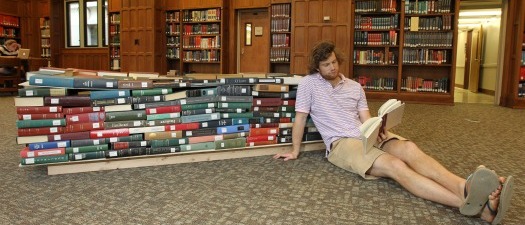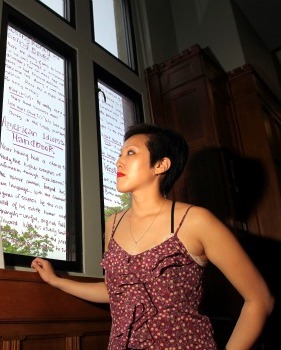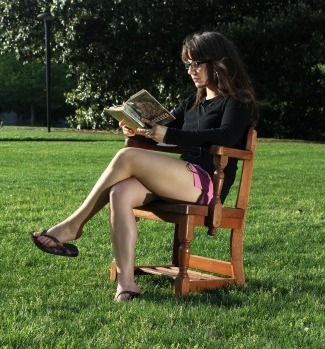Art installations titled ‘heard mentality’

Red lipstick, a book-filled coffin and books that look like packaged meat are among the items in a student art exhibit at Vanderbilt University’s Central Library through May 13. The role of language and books in current culture and the impact of reading material on personal experiences are among the themes for the installations, titled “heard mentality.”
Participating students are enrolled in an art installation and social intervention course taught by Mel Ziegler, professor and chair of the Department of Art. This marks the third year that Ziegler’s students have used the library to create these highly unusual art works.
The title “heard mentality” came out of a brainstorming session among the students, according to Jonathan Gendzier, a senior in the College of Arts and Science. “We wanted to convey that people should think for themselves instead of following a herd mentality,” he said. “Of course, it’s also a play on the name on Vanderbilt’s libraries – Jean and Alexander Heard. It also ties in with the theme of hearing words.”

For the assignment, Benjy Hansen-Bundy, a senior in the College of Arts and Science, built a tomb out of books and named the installation Dead White Males. The idea was sparked by his reading of books by white men who are long gone. “I want people to reconsider our approach to books and to think about what we are taking from them,” Hansen-Bundy said. “What guidance can they provide for our own lives?” In an effort to dramatize the importance of experiential learning, he spent one morning lying inside the tomb, located in the Payne Room on the sixth floor.
Also in the Payne Room is Read Room, created by Jean Kang, a senior in the College of Arts and Science. She used red lipstick to dramatize the importance of words and language as a major source of communication for library items. Kang covered the windows between columns of books about words with excerpts and texts written in red lipstick. “The red lipstick allows me to play off of the pronunciation for the word ‘read,’ which ties into the installation’s theme,” Kang said.
Lauren Richman created Exsanguination in the sixth floor stacks. The senior in the College of Arts and Science noticed an area with several empty shelves. “My project uses a metaphor of the meat locker to express the transformative state that book objects are undergoing from tangible to digital objects,” Richman said. “I have red books in clear packaging hanging from the ceiling. The digitization of books into databases could be compared to changing from inedible to edible materials.”
Wenhao Liu, a junior in the College of Arts and Science, titled his installation New Space. “My project explores the possibility of creating a new environment in the reading room. I want the reader to enter a new world while in the space by making three dimensional the reading experience,” Liu said. Red decorations (a play on the word “read”) now hang from the ceiling in the middle of the Parkes Armistead Room on the fourth floor to give the illusion of separating it into two sections.

Candace Jones chose to give a performance with her installation, Recite. The senior in the College of Arts and Science sat on Library Lawn one afternoon and read aloud from fictional novels that students had recently returned to the library. Jones’ project was inspired by her mother’s visit to the Peabody Library, where she found that many books had been replaced by computer stations. “I wanted to celebrate the perpetual transformation of the library in conjunction with mourning the apparent death of some analog texts.”
Gendzier, also a senior in the College of Arts and Science, named his installation Venture Forth. He placed bookmarks on about 35 books located on the seventh floor. “On each bookmark is written a short message serving to remind the reader to follow through on carrying out adventures or experiences imagined while reading the book,” he said. “Given potentially long intervals between book checkouts, inserts will be left in books indefinitely, so this is a continuing art project.”
Ziegler said that he was proud of his students’ installations. “This year was a little different than in the past since this course was not only an installation class but also one that focused on social interventions. That is certainly reflected in the students’ work.”